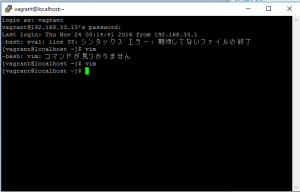サーバーテストツール
http://serverspec.org/resource_types.html
With Serverspec, you can write RSpec tests for checking your servers are configured correctly.
Serverspec tests your servers’ actual state by executing command locally, via SSH, via WinRM, via Docker API and so on. So you don’t need to install any agent softwares on your servers and can use any configuration management tools, Puppet, Ansible, CFEngine, Itamae and so on.
http://serverspec.org/
vagrant fileをつくり、サーバーを二つ起動します。
# config.vm.box = "bento/centos-6.7"
config.vm.define "host" do |node|
node.vm.box = "bento/centos-6.7"
node.vm.hostname = "host"
node.vm.network :private_network, ip: "192.168.33.13"
end
config.vm.define "web" do |node|
node.vm.box = "bento/centos-6.7"
node.vm.hostname = "web"
node.vm.network :private_network, ip: "192.168.33.14"
end
.ssh/config
Host web
HostName 192.168.33.14
[vagrant@host ~]$ vi .ssh/config
[vagrant@host ~]$ chmod 600 .ssh/config
[vagrant@host ~]$ ssh-keygen -t rsa
[vagrant@host ~]$ ssh-copy-id web
[vagrant@host ~]$ gem install itamae serverspec
serverspec start
[vagrant@host myproject]$ serverspec-init
Select OS type:
1) UN*X
2) Windows
Select number: 1
Select a backend type:
1) SSH
2) Exec (local)
Select number: 1
Vagrant instance y/n: n
Input target host name: web
+ spec/
+ spec/web/
+ spec/web/sample_spec.rb
+ spec/spec_helper.rb
+ Rakefile
+ .rspec
/myproject/spec/web/httpd_spec.rd
require 'spec_helper'
describe package('httpd') do
it { should be_installed }
end
rakeコマンドでテストします。
[vagrant@host myproject]$ rake spec
/home/vagrant/.rbenv/versions/2.2.2/bin/ruby -I/home/vagrant/.rbenv/versions/2.2.2/lib/ruby/gems/2.2.0/gems/rspec-support-3.5.0/lib:/home/vagrant/.rbenv/versions/2.2.2/lib/ruby/gems/2.2.0/gems/rspec-core-3.5.4/lib /home/vagrant/.rbenv/versions/2.2.2/lib/ruby/gems/2.2.0/gems/rspec-core-3.5.4/exe/rspec --pattern spec/web/\*_spec.rb
Package "httpd"
should be installed (FAILED - 1)
Failures:
1) Package "httpd" should be installed
On host `web'
Failure/Error: it { should be_installed }
expected Package "httpd" to be installed
sudo -p 'Password: ' /bin/sh -c rpm\ -q\ httpd
package httpd is not installed
# ./spec/web/httpd_spec.rb:4:in `block (2 levels) in '
Finished in 1.33 seconds (files took 0.64117 seconds to load)
1 example, 1 failure
Failed examples:
rspec ./spec/web/httpd_spec.rb:4 # Package "httpd" should be installed
/home/vagrant/.rbenv/versions/2.2.2/bin/ruby -I/home/vagrant/.rbenv/versions/2.2.2/lib/ruby/gems/2.2.0/gems/rspec-support-3.5.0/lib:/home/vagrant/.rbenv/versions/2.2.2/lib/ruby/gems/2.2.0/gems/rspec-core-3.5.4/lib /home/vagrant/.rbenv/versions/2.2.2/lib/ruby/gems/2.2.0/gems/rspec-core-3.5.4/exe/rspec --pattern spec/web/\*_spec.rb failed
/coockbook/recipe.rb
package 'httpd'
[vagrant@host myproject]$ itamae ssh -h web cookbooks/recipe.rb
INFO : Starting Itamae...
INFO : Recipe: /home/vagrant/myproject/cookbooks/recipe.rb
INFO : package[httpd] installed will change from 'false' to 'true'
[vagrant@host myproject]$ rake spec
/home/vagrant/.rbenv/versions/2.2.2/bin/ruby -I/home/vagrant/.rbenv/versions/2.2.2/lib/ruby/gems/2.2.0/gems/rspec-support-3.5.0/lib:/home/vagrant/.rbenv/versions/2.2.2/lib/ruby/gems/2.2.0/gems/rspec-core-3.5.4/lib /home/vagrant/.rbenv/versions/2.2.2/lib/ruby/gems/2.2.0/gems/rspec-core-3.5.4/exe/rspec --pattern spec/web/\*_spec.rb
Package "httpd"
should be installed
Finished in 0.62513 seconds (files took 0.37567 seconds to load)
1 example, 0 failures




